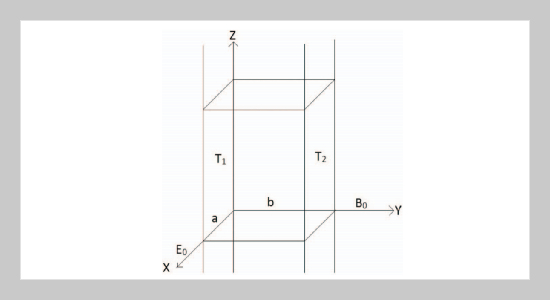REFERENCES
- [1] Aung, W. and Worku, G., “Theory of Fully Developed Combined Convection Including Flow Reversal,” ASME J Heat Transf., Vol. 108, pp. 485�488 (1986). doi: 10. 1115/1.3246958
- [2] Aung, W. and Worku, G., “Developing Flow and Flow Reversal in a Vertical Channel with Asymmetric Wall Temperature,” ASME J Heat Transf., Vol. 108, pp. 299�304 (1986). doi: 10.1115/1.3246919
- [3] Giuseppe, S. and Michele, C., “Fully Developed Mixed Magnetohydrodynamic Convection in a Vertical Square Duct,” Numer. Heat Transfer A., Vol. 53, pp. 907�924 (2008). doi: 10.1080/00397910601149934
- [4] Chang, C. C. and Lundgren, T. S., “Duct Flow in Magnetohydrodynamics,” Z. Angew. Math. Phys. (ZAMP), Vol. 12, pp. 100�114 (1961). doi: 10.1007/BF01601011
- [5] Hunt, J. C. R., “Magnetohydrodynamic Flow in a Rectangular Duct,” J. Fluid Mech., Vol. 21, No. 4, pp. 577�590 (1965). doi: 10.1017/S0022112065000344
- [6] Uflyand, Y. S., “Flow of Conducting Fluid in a Rectangular Channel in a Transverse Magnetic Field,” Sov. Phys. Tech. Phys., Vol. 5, p. 1194 (1961). doi: 10.1063/ 1.3624837
- [7] Romig, M., “The Influence of Electric and Magnetic Field on Heat Transfer to Electrically Conducting Fluids,” Adv Heat Transf., Vol. 1, pp. 268�352 (1964). doi: 10.1016/S0065-2717(08)70100-X
- [8] Sutton, G. W. and Sherman, A., Engineering Magnetohydrodynamic, McGraw-Hill, New York (1965).
- [9] Alpher, R. A., “Heat Transfer in Magnetohydrodynamic Flow between Parallel Plates,” Int J Heat Mass Transf., Vol. 3, pp. 108�112 (1960). doi: 10.1016/0017- 9310(61)90073-4
- [10] Nigam, S. D. and Singh, S. N., “Heat Transfer by Laminar Flow between Parallel Plates under the Action of Transverse Magnetic Field,” Q J Mech Appl Math., Vol. 13, pp. 85�97 (1960). doi: 10.1093/qjmam/13.1.85
- [11] Winter, H. H., “Viscous Dissipation in Shear Flows of Polymers,” Adv Heat Transf., Vol. 13, pp. 205�267 (1977). doi: 10.1016/S0065-2717(08)70224-7
- [12] Shadid, J. N. and Eckert, E. R. G., “Viscous Heating of a Cylinder with Finite Length by a High Viscosity Fluid in Steady Longitudinal Flow,” Int J Heat Mass Transf., Vol. 35, pp. 2739�2749 (1992). doi: 10.1016/ 0017-9310(92)90114-8
- [13] Buhler, L., “Laminar Buoyant Magnetohydrodynamic Flow in a Rectangular Duct,” Phys Fluids., Vol. 10, pp. 223�236 (1998). doi: 10.1063/1.869562
- [14] Yakubenko, A. E., “Calculation of the Flow of an Electrically Conducting Liquid in a Duct of Rectangular Cross Section with Electrodes,” Fluid Dynamic, Vol. 5, pp. 748�751 (1970). doi: 10.1007/BF01017291
- [15] Prabal, T. and Mitesh, S., “Analysis of Laminar Mixed Convective Heat Transfer in Horizontal Triangular Ducts,” Numerical Heat Transfer, Part A., Vol. 54, pp. 1148�1168 (2008). doi: 10.1080/10407798508552113
- [16] Sparrow, E. M. and Cess, R. D., “Temperature Dependent Heat Sources or Sinks in a Stagnation Point Flow,” Appl Sci Res A., Vol. 10, pp. 185�197 (1961). doi: 0.1007/BF00411912
- [17] Chamkha, A. J., “On Laminar Hydromagnetic Mixed Convection Flow in a Vertical Channel with Symmetric and Asymmetric Wall Heating Conditions,” Int Commun Heat Mass Transf., Vol. 45, pp. 2509�2525(2002). doi: 10.1016/S0017-9310(01)00342-8
- [18] Jha, B. K. and Ajibade, A. O., “Free Convective Flow of Heat Generating/Absorbing Fluid between Vertical Porous Plates with Periodic Heat Input,” Int. Comm. Heat Mass Transfer., Vol. 36, p. 624 (2009). doi: 10. 1016/j.icheatmasstransfer.2009.03.003
- [19] Kamel, M. H., “Unsteady MHD Convection through Porous Medium with Combined Heat and Mass Transfer with Heat Source/Sink,” Energy Conversion and Management, Vol. 42, p. 393 (2001). doi: 10.1016/ S0196-8904(00)00067-4
- [20] Umavathi, J. C., Liu, I. C., Prathap Kumar, J. and Pop, I., “Fully Developed Magneto Convection Flow in a Vertical Rectangular Duct,” Heat Mass Transfer, Vol. 47, pp. 1�11 (2011). doi: 10.1007/s00231-010-0650-2
- [21] Umavathi, J. C. and Liu, I. C., “Magnetoconvection in a Vertical Channel with Heat Source or Sink,” Meccanica, Vol. 48, pp. 2221�2232 (2013). doi: 10.1007/ s11012-013-9739-2
- [22] Hughes, W. F. and Young, F. J., The Electro Magneto Hydrodynamics of Fluids, Wiley, New York (1996).
















